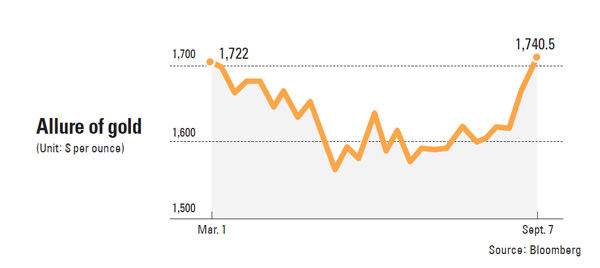Gold’s glitter keeps getting brighter

Gold has proved itself the strongest and safe asset in a sluggish global economy.
The gold price hit a six-month high sparked by strong global cues coupled with the European Central Bank’s bond-buying plan.
The precious metal in New York sold for $1,740.5 an ounce Friday after edging up $34.90 on Thursday (Central Standard Time).
Gold hovered around the $200 something per ounce level in 2000. Its price spiked to $1,900 less than a month after the euro zone debt crisis surfaced in August 2011, but in November it started sinking, and it seemed that the long-held formula of “gold is equal to safe haven” had been broken.
It jumped again earlier this year, but dropped again in March and went down to the level of $1,500 something per ounce in May.
In a shareholder letter in February, Berkshire Hathaway Chairman Warren Buffett wrote gold investment is “forever unproductive.”
“A century from now the 400 million acres of farmland will have produced staggering amounts of corn, wheat, cotton and other crops - and will continue to produce that valuable bounty, whatever the currency may be,” Buffett wrote. “Exxon Mobil will probably have delivered trillions of dollars in dividends to its owners and will also hold assets worth many more trillions - and, remember, you get 16 Exxons. The 170,000 tons of gold will be unchanged in size and still incapable of producing anything. You can fondle the cube, but it will not respond.” Chart Prophet Capital’s chief investment strategist, Yoni Jacobs, sided with Buffett in June when the gold price struggled.
“Technical levels show us when the trouble is coming,” Jacobs said. Gold struggled at $1,700 and then at $1,600. If it breaks through the next key level of $1,500, which could be approaching soon, investors would start panicking and selling hard,” Jacobs said in an interview with CNBC in June. “It appears that the market has decided on gold’s fate. And it’s not looking pretty. It looks like gold is about to see prices collapse and is on its way to $700.”
In April, Jacobs published a book called “Gold Bubble,” which predicted the collapse of gold prices.

Market observers say this is a second gold rally. The first happened in the 1970s and 1980s when then U.S. President Richard Nixon in 1971 killed the gold standard, a monetary system in which the standard economic unit of account is a fixed weight of gold. As commodity prices spiked with the oil shock, gold became popular as a haven against inflation. The Soviet Union’s invasion of Afghanistan also pushed gold prices. In January 1980, an ounce of gold neared the $900 level.
The second gold rally began in 2000 when its price rebounded. Gold emerged as one of the best alternative investments to stocks when their prices plunged due to the bursting of the high-tech bubble. The U.S. government’s war on terrorism also pushed up the gold price as the U.S. dollar weakened. The snowballing U.S. debt pushed down the value of the dollar and investors began hunting gold.
Experts said the development of China and India also boosted demand for gold. Demand rose further when fund managers created gold-backed exchange-traded funds (ETF), a commodity fund consisting of gold backed contracts and derivatives. First created in 2003, Gold ETFs, have proved a popular way to invest in gold given that they now account for 2,000 metric tons of metal. The demand outstripped gold supply in the 2000s. According to the World Gold Council, demand for gold stood at 4,574 metric tons last year, but its supply fell short of it at 4,497 metric tons.
Some market observers think gold prices went up too high and maybe it’s now time they will recede.
Peter Tasker, a Tokyo-based analyst with Arcus Research, wrote in The Financial Times last month that the gold price has become “strangely insensitive to the usual stimuli” and that gold has become just another risky asset that resembles stock markets.
“According to the Web site pricedingold.com, gold is at a 120-year high (at least) relative to U.S. house prices,” Tasker wrote. “Likewise, it is at a 74-year high relative to U.S. wages, at multigeneration highs relative to wheat, coffee and cocoa and at the same price relative to the cost of a Yale education as in the first decade of the 20th century.”
The gold price has gone up in a few months in anticipation of the U.S. government’s additional quantitative easing.
When more dollars are poured into the market, the dollar will weaken and investors who fear inflation will naturally flock to gold. Thomson Reuters GFMS Chairman Philip Klapwijk told The Financial Times that gold prices are likely to be “driven above $2,000” in the next half of year.
By Ko Ran [mijukim@joongang.co.kr]










with the Korea JoongAng Daily
To write comments, please log in to one of the accounts.
Standards Board Policy (0/250자)